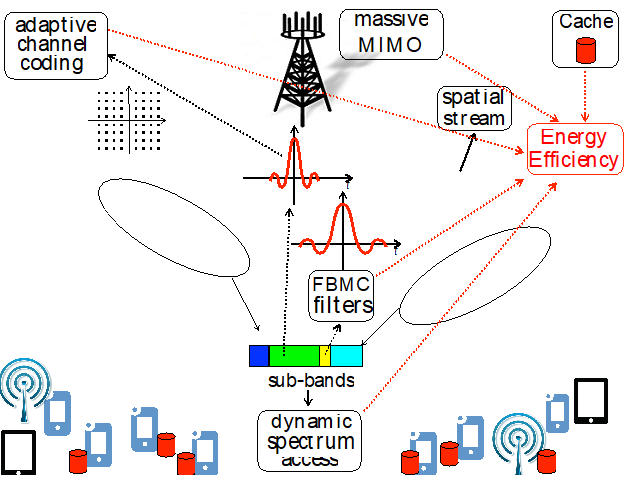SpecEES: Dynamic Space Frequency Multiplexing – A New Paradigm for Filterbank Multicarrier Spectrum Access
Funded by: NSF
PI: Behrouz Farhang-Boroujeny
co-PIs: Rong-Rong Chen, Sneha K. Kasara, and Mingyue Ji
Project Summary
The exponential growth of mobile data traffic has driven wireless communication technologies at an unprecedented pace. However, the amount of available spectrum, considered as the most expensive entity in modern communications, has not kept pace. Our idea is to develop a unique approach for broadband spectrum access termed dynamic space frequency multiplexing. This approach is built upon two complementary technologies – Filter Bank Multicarrier (FBMC) for frequency multiplexing and Massive MIMO for spatial multiplexing. Even though in the past decade FBMC has received a lot of attentions from European countries, studies on FBMC have been quite limited in the United States. Despite its popularity and many advantages, Orthogonal Frequency-Division Multiplexing (OFDM) suffers from a number of serious drawbacks such as large side-lobes of filters (leading large guard bands and difficulty of carrier aggregation) and high requirement for synchronization. FBMC waveform is constructed based on a prototype filter whose locality in both time and frequency can be controlled. This flexibility in design lead to the following advantages: (i) users that are allocated different portions of the spectrum need not to be synchronized; (ii) carrier aggregation become a trivial task; (iii) dynamic space frequency multiplexing can be integrated easily; (iv) interference among primary and secondary users is minimized; (v) by controlling the locality of the prototype filter in time, network adoption to time-varying channels is possible.
On the other hand, the emerging technology of massive MIMO offers complementary benefits to that of FBMC through spatial multiplexing. Nevertheless, due to the practical design constraints (e.g., few RF chains due to energy constraint), efficient frequency multiplexing schemes are also important for practical design of massive MIMO systems. We believe that a new design that can reap the benefits of both spatial multiplexing and sharp frequency multiplexing for user separation is critical to achieve high spectral and energy efficiency in dynamic spectrum access. Despite the fact that the jointly design of FBMC and massive MIMO is a non-trivial task based on the properties of FBMC, the proposed dynamic space frequency multiplexing (DSFM) based on FBMC and massive MIMO can indeed offer such a viable solution.
In this project, we aim to jointly design FBMC and massive MIMO to maximize the mutual benefits of the two systems. In addition, we propose a holistic cross-layer system design approach including the key components from the physical layer (FBMC, massive MIMO, adaptive channel coding), Medium Access (MAC) Layer (dynamic spectrum sharing), and application layer (caching) such that the optimal trade-off between spatial efficiency and energy efficiency can be achieved. The main thrusts of the project are: (1) Adaptive FBMC prototype filter design for DSFM and theoretical analysis to characterize performance limits. (2) Design of energy-efficient hybrid beamforming for DSFM and characterization of spectral and energy efficiency trade-off. (3) Design of rate-adaptive and low-power channel encoding and decoding algorithms for dynamic spectrum access. (4) Energy-aware FBMC-based MAC layer design for dynamic space frequency multiplexing. (5) An application layer cache-aided dynamic spectrum access for improving spectral and energy efficiency (6) Validation on a testbed.

